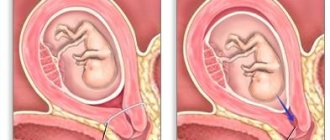Abdominal surgery to deliver a baby from the mother's abdomen is called a caesarean section. It is carried out when natural childbirth is contraindicated and poses a threat to both the health of the mother and the child.
If a caesarean section is planned and there is time to prepare the woman in labor for it, the woman herself can choose the method of pain relief, but in most cases it is determined individually by the anesthesiologist. Today, the following methods of anesthesia for caesarean section are used:
Abdominal surgery to deliver a baby from the mother's abdomen is called a caesarean section. It is carried out when natural childbirth is contraindicated and poses a threat to both the health of the mother and the child.
If a caesarean section is planned and there is time to prepare the woman in labor for it, the woman herself can choose the method of pain relief, but in most cases it is determined individually by the anesthesiologist. Today, the following methods of anesthesia for caesarean section are used:
- epidural;
- spinal;
- general.
When choosing one of them, you should consider the following factors:
- Do you want to be unconscious for the entire duration of the operation and already wake up in the ward as a happy mother;
- or you have a desire to “be present” during the operation.
No type of anesthesia is desirable for a child, but the greatest risk of complications is associated with general anesthesia, when several medications are administered into the mother’s body at once.
Let's take a closer look at each method of anesthesia for caesarean section.
How is surgery performed?
Before you find out which anesthesia is better for a caesarean section, you should say a few words about the essence of this surgical intervention.
During a caesarean section, the newborn is not delivered naturally (through the birth canal), but is removed through a small incision that the surgeon makes in the wall of the uterus. In modern maternity hospitals, the incision is made in the lower abdomen, making the scar after the operation almost invisible. This method of obstetrics is very common and widely used in practice: in some European countries, for example in Germany, up to 40% of babies are born this way.
There are two types of surgical intervention: planned and emergency. The first is done if there is a risk of developing any complications during natural childbirth that threaten the life and health of the mother and baby. Indications for this operation include the mother’s pelvis being too narrow, the threat of hypoxia, labor that began prematurely, multiple pregnancies, etc. Naturally, planned surgical intervention is the more preferable option, since there is time to prepare the woman in labor for the upcoming operation.
Emergency surgery is performed if any dangerous complications arise during natural childbirth. At the same time, emergency surgery in most cases is carried out using general anesthesia, one of the main advantages of which is the rapid onset of the anesthetic effect: this is very important, because sometimes during complicated childbirth the minutes count.
View gallery
Naturally, such a surgical operation is unthinkable without the use of anesthesia, otherwise the patient may not survive the painful shock.
What types of pain relief are used for caesarean section?
There are two main types of anesthesia that can be used during a caesarean section: regional and general anesthesia. The first completely deprives of sensitivity only the lower half of the body, while with the general one the patient’s consciousness is completely turned off and all her muscles relax. At the same time, the choice of an adequate and most suitable method of anesthesia can only be made by a doctor, taking into account the characteristics of the course of pregnancy, the state of the mother’s health and many other factors.
Types of anesthesia for caesarean section:
- general anesthesia;
- spinal;
- epidural.
The main advantages and disadvantages of each of them are described below.
When can the choice be made in favor of general anesthesia?
The essence of general anesthesia is that, thanks to a complex of drugs that are injected into the venous bloodstream or through a tube inserted into the respiratory tract, the patient completely loses consciousness and ceases to experience pain. It is important to note that during general anesthesia, muscle relaxation is observed, which makes it possible to create comfortable working conditions for the obstetrician surgeon.
View gallery
This type of pain relief for women undergoing a caesarean section is relatively rarely chosen. The need for general anesthesia may arise in the following cases:
- the presence of contraindications to other existing methods of pain relief;
- the woman in labor is obese;
- the fetus is diagnosed with hypoxia;
- woman’s refusal to use other types of pain relief;
- abnormal position of the fetus in the uterus, prolapse of the umbilical cord and other obstetric emergencies.
Nowadays, general anesthesia for caesarean section is used if there is a need to perform it for emergency reasons, and surgical intervention needs to be started urgently in order to save the lives of the woman in labor and the child. This is due to the fact that general anesthesia has a number of significant disadvantages.
Caesarean section under general anesthesia
General anesthesia for caesarean section is often used in emergency cases. Its essence lies in the fact that pain relief occurs due to the intravenous administration of anesthetics or the use of an anesthesia mask. In this case, the woman in labor is in a state of sleep. The duration of the procedure depends on the dose and type of drug; it can range from 10 to 70 minutes.
Caesarean section under general anesthesia is indicated if the operation is performed as an emergency and there is a threat to the life of the woman in labor or the fetus, spinal and epidural anesthesia are contraindicated, placenta accreta, oblique or transverse position of the fetus is detected. This type of anesthesia has virtually no contraindications. If possible, it should not be used for acute diseases of the cardiovascular and respiratory systems.
After general intravenous anesthesia, the risk of developing the following complications is quite high:
- headache;
- dizziness;
- short-term disorientation in space and time;
- confusion;
- muscle pain.
It is also possible that brain function may be depressed due to the effects of drugs. This type of anesthesia causes more harm to the child than the previous two. The drugs have a toxic effect on the central nervous system, breathing problems and lethargy may occur.
Caesarean section under general anesthesia also has positive aspects: pain relief is always complete, the muscles are relaxed, and the surgeon has the opportunity to carry out all the necessary manipulations.
The drugs act very quickly, without inhibiting the functioning of the heart and blood vessels. If necessary, anesthesia can be intensified and prolonged.
General anesthesia leads to hypoxia in a woman in labor faster than other methods. When artificial ventilation is connected, an increase in pressure and an increase in heart rate are sometimes noted.
Drugs administered intravenously have a significant effect on the functioning of the child’s nervous system. This negatively affects his condition, especially with premature pregnancy, hypoxia and developmental defects.
Disadvantages of general anesthesia
What anesthesia is better for caesarean section? Before answering this question, let's talk about its disadvantages. Doctors try to avoid this type of anesthesia during cesarean section, since anesthesia can cause many more complications compared to other pain management methods. Among the most common it is worth highlighting:
- hypoxia of the woman in labor, which is caused by the fact that during anesthesia the volume of the lungs decreases and the body’s need for oxygen increases;
- there is a high risk of aspiration, that is, gastric contents entering the respiratory tract: if the anesthesiologist does not diagnose this condition in a timely manner, the consequences can be disastrous;
- Many women in labor experience increased blood pressure during general anesthesia.
The anesthetic can lead to disruption of the newborn's respiratory activity, as well as have a depressing effect on his nervous system due to the penetration of painkillers through the placenta. The latter is especially dangerous if general anesthesia is used for premature birth. However, there is no need to be too afraid: modern medications can reduce the risk of developing negative consequences for the child to a minimum, and the newborn also receives special medications that relieve the effects of general anesthesia.
View gallery
Thus, which anesthesia is best for a caesarean section is up to you and your doctor to decide, but remember that general anesthesia is far from the best way to relieve pain from the operation, and you should resort to it only if there are no other options for one reason or another. remains. For example, if a woman in labor has an unstable psyche or suffers from any psychiatric illnesses, the operation can only be performed under general anesthesia, because there is a high risk that the woman will not be able to remain calm during the operation and will interfere with the surgeon’s actions.
Much more often in practice, epidural and spinal anesthesia are used, that is, regional methods of pain relief - these types are much safer, and also allow the woman to be in a state of clear consciousness during childbirth. This is important not only because she has the opportunity to immediately hold the newborn. During a cesarean section, the obstetrician and anesthesiologist can maintain constant contact with the patient, which makes it easier to identify possible complications.
Caesarean section is a surgical procedure in which the newborn is removed through an incision in the abdominal wall and uterus. Thanks to this procedure, thousands of children are born every year, so the question of how this operation is carried out worries many future parents. At the same time, one of the most important points to think about on the eve of childbirth is the type of pain relief. So, which anesthesia is better for a caesarean section? From the article you can find out basic information about the most commonly used types of pain relief during this operation, their main advantages and disadvantages.
How is surgery performed?
Before you find out which anesthesia is better for a caesarean section, you should say a few words about the essence of this surgical intervention. During a caesarean section, the baby is not delivered naturally (through the birth canal), but is pulled out through a small incision that the surgeon makes in the wall of the uterus. In modern maternity hospitals, the incision is made in the lower abdomen, making the scar after the operation almost invisible. This method of obstetrics is very common and widely used in practice: in some European countries, for example in Germany, up to 40% of babies are born this way. There are two types of surgical intervention: planned and emergency. The first is done if there is a risk of developing any complications during natural childbirth that threaten the life and health of the mother and baby. Indications for this operation include the mother’s pelvis being too narrow, the threat of hypoxia, labor that began prematurely, multiple pregnancies, etc. Naturally, planned surgery is the preferable option, since there is time to prepare the mother in labor for the upcoming operation.
Emergency surgery is performed if any dangerous complications arise during natural childbirth. At the same time, emergency surgery in most cases is carried out using general anesthesia, one of the main advantages of which is the rapid onset of the anesthetic effect: this is very important, because sometimes during complicated childbirth the minutes count.
Naturally, such a surgical operation is unthinkable without the use of anesthesia, otherwise the patient may not survive the painful shock.
What types of pain relief are used for caesarean section?
There are two main types of anesthesia that can be used during a caesarean section: regional and general anesthesia. The first completely deprives of sensitivity only the lower half of the body, while with the general one the patient’s consciousness is completely switched off and all her muscles relax. At the same time, the choice of an adequate and most suitable method of anesthesia can only be made by a doctor, taking into account the characteristics of the course of pregnancy, the state of the mother’s health and many other factors. Types of anesthesia for caesarean section:
- general anesthesia;
- spinal;
- epidural.
The main advantages and disadvantages of each are described below.
When can the choice be made in favor of general anesthesia?
The essence of general anesthesia is that, thanks to a complex of drugs that are injected into the venous bloodstream or through a tube inserted into the respiratory tract, the patient completely loses consciousness and stops feeling pain. It is important to note that during general anesthesia, muscle relaxation is observed, which makes it possible to create comfortable working conditions for the obstetrician surgeon.
This type of pain relief for women undergoing a caesarean section is relatively rarely chosen. The need for general anesthesia may arise in the following cases:
- the presence of contraindications to other existing methods of pain relief;
- the woman in labor is obese;
- the fetus is diagnosed with hypoxia;
- woman’s refusal to use other types of pain relief;
- abnormal position of the fetus in the uterus, prolapse of the umbilical cord and other obstetric emergencies.
Nowadays, general anesthesia for caesarean section is used if there is a need to perform it for emergency reasons, and surgical intervention must be urgently undertaken to save the life of the woman in labor and the child. This is due to the fact that general anesthesia has a number of significant disadvantages.
Disadvantages of general anesthesia
What anesthesia is better for caesarean section? Before answering this question, let's talk about its disadvantages. Doctors try to avoid this type of anesthesia during cesarean section, since anesthesia can lead to a much greater number of complications compared to other methods of pain relief. Among the most common are:
- hypoxia of the woman in labor, which is caused by the fact that during anesthesia the volume of the lungs decreases and the body’s need for oxygen increases;
- a high risk of aspiration, that is, gastric contents entering the respiratory tract: if the anesthesiologist does not diagnose this condition in a timely manner, the consequences can be disastrous;
- Many women in labor experience increased blood pressure during general anesthesia.
The anesthetic can lead to disruption of the newborn's respiratory activity, as well as have a depressing effect on his nervous system due to the penetration of painkillers through the placenta. The latter is especially dangerous if general anesthesia is used for premature birth. However, there is no need to be too afraid: modern medications can reduce the risk of developing negative consequences for the child to a minimum, and the newborn also receives special medications that relieve the effects of general anesthesia.
Thus, which anesthesia is best for a caesarean section is up to you and your doctor to decide, but remember that general anesthesia is far from the best way to relieve pain from the operation, and you should resort to it only if there are no other options for one reason or another remains. For example, if a woman in labor has an unstable psyche or suffers from any psychiatric illnesses, the operation can only be performed under general anesthesia, because there is a high risk that the woman will not be able to remain calm during the operation and will interfere with the surgeon’s actions. Much more often in practice, epidural and spinal anesthesia are used, that is, regional methods of pain relief - these types are much safer, and also allow the woman to be in a state of clear consciousness during childbirth. This is important not only because she has the opportunity to immediately hold the newborn in her arms. During a cesarean section, the obstetrician and anesthesiologist can maintain constant contact with the patient, which makes it easier to identify possible complications.
Epidural anesthesia procedure
Before answering the question of what is the best anesthesia for a caesarean section, you should find out what epidural anesthesia is. This is a procedure in which an anesthetic is injected into the epidural space of the spine in the lumbar region. After anesthesia produced by this method, the woman in labor is conscious during the operation, but does not experience any pain. Local anesthesia for caesarean section allows the woman to take an active part in the birth process: communicate with the medical staff or her husband present in the room, immediately pick up the newborn and put him to the breast. In this case, the woman in labor does not feel pain, although some note slight discomfort during the operation. True, there is one very important nuance. Many women find it psychologically difficult to decide to stay in the operating room; they are afraid that during a caesarean section they will be conscious and not feel half of their body. Often, women in labor insist on general anesthesia. It is advisable to discuss your fears with your doctor and anesthesiologist, who will tell you in detail how the pain relief procedure will take place.
Benefits of Epidural Anesthesia
Among the main advantages of epidural anesthesia are the following:
- Stable functioning of the cardiovascular system, absence of pressure surges.
- Maintaining the ability to move.
- There is no injury to the upper respiratory tract and there is no risk of aspiration.
- Long duration of anesthetic effect. If necessary, anesthesia can be extended for any period, which is very important if, after a caesarean section, it is necessary to perform any other operations, for example, tubal ligation.
- The woman recovers from anesthesia quite quickly, the postoperative recovery period is shortened: just 24 hours after the operation, many patients can get up and move independently.
- The baby can be picked up and placed to the breast immediately after the operation.
- It is possible to reduce pain after childbirth by injecting painkillers into the epidural space.
Disadvantages of epidural anesthesia
Despite all its benefits, the consequences of epidural anesthesia for caesarean section can be disappointing. Every expectant mother in labor should know this:
- If the anesthetic is administered by an insufficiently experienced specialist, there is a high risk of the drug entering the bloodstream. At the same time, convulsions develop, blood pressure drops sharply and consciousness is depressed. The result may be the death of the mother in labor or irreversible damage to the nervous system.
- In about 17% of cases, the anesthesia fails to block certain nerves, causing the woman in labor to experience discomfort during a C-section. Therefore, before starting surgery, it is necessary to check sensitivity using special neurological tests, such as pin pricks. If the anesthetic does not work properly, repeated administration of the drug is required.
- If the medication gets under the arachnoid membrane of the spinal cord due to improper insertion of the catheter, a spinal block may occur, which often results in failure of the respiratory system. To avoid this, a small dose of the drug is administered first: the surgical team only needs to wait two minutes to determine whether the procedure was performed correctly.
Unfortunately, epidural anesthesia for caesarean section is quite complex, and its success often depends on the experience and skills of the specialist. Tactile detection of the epidural space is quite uncertain, while during spinal anesthesia, a reliable marker is the emergence of cerebrospinal fluid to the surface. Therefore, it is important to choose a doctor who inspires your trust and carefully study reviews about the work of the maternity hospital where your baby will be born.
Spinal anesthesia
At first, epidural anesthesia seemed like a real salvation, because it not only made it possible to make the process of giving birth to a child absolutely painless, but also gave women the opportunity not to lose clarity of thinking and perception at the moment of the birth of the long-awaited baby. However, due to numerous contraindications and the likelihood of a number of negative consequences listed above, epidural anesthesia is gradually giving the palm to spinal anesthesia. Many people claim that this is the best anesthesia for caesarean section.
Spinal anesthesia involves the injection of an anesthetic into the lumbar region of the back. The drug enters the subarachnoid space of the spinal cord. Moreover, the effect of both types of anesthesia is similar: some time after the injection, the woman in labor ceases to feel the lower half of her body, and the doctor can begin the necessary surgical procedures.
Pros of spinal anesthesia
What anesthesia is best for caesarean section? It is quite difficult to answer this question, since everything is individual. But we can highlight the main advantages of spinal anesthesia:
- No toxic effect. If the anesthetic accidentally gets into the bloodstream, there are practically no reactions from the heart or nervous system, and there is no risk to the child.
- After the operation, the body recovers quite quickly.
- High-quality pain relief: during the operation, the woman in labor does not feel pain.
- Spinal anesthesia additionally relaxes the muscles, which makes the doctor's work easier.
- The operation can begin a few minutes after the drug is administered, so the intervention takes less time.
- Spinal anesthesia is much easier to administer than epidural. In addition, the anesthesiologist uses a much thinner needle to administer the drug, thereby minimizing the risk of spinal cord injury or erroneous administration of anesthetic.
- Many doctors recognize spinal anesthesia as the perfect option for cesarean section anesthesia.
Spinal anesthesia for caesarean section: contraindications and main disadvantages
Unfortunately, spinal anesthesia also has some disadvantages:
- The drug is effective for two hours, so this type of anesthesia is not suitable if it is necessary to perform any additional manipulations, and if complications arise during the operation, additional anesthesia may be required.
- Spinal anesthesia is not possible if the patient has certain types of spinal injuries.
- Due to the rapid onset of anesthesia, blood pressure may decrease.
- If the instruments used to administer the drugs were not thoroughly disinfected, various infectious complications, such as meningitis, may occur.
- After surgery, many women in labor experience severe headaches that can last for several days or even weeks.
- As a result of improper insertion of the catheter, it can cause a nerve center called the “cauda equina.” This may cause the innervation of the sacrum and lumbar region to be disrupted.
- Spinal anesthesia is not possible for some forms of spinal deformity.
- Spinal anesthesia is not possible for premature placental abruption and some other obstetric conditions.
Despite the disadvantages listed above, spinal anesthesia is considered one of the best and safest techniques for pain relief during caesarean section.
Pain relief for caesarean section: reviews
What anesthesia is better for caesarean section? Feedback about how women feel during this or that type of anesthesia will help us find the answer to this question. Young mothers note that the process of emerging from general anesthesia is quite unpleasant: there is a feeling of clouding of consciousness, nausea, headaches and muscle pain. In addition, there is no opportunity to hold the baby in your arms immediately after birth. There is another negative consequence of general anesthesia: often after it the child experiences respiratory depression. What anesthesia is better for caesarean section? Reviews about epidural anesthesia are mostly positive. Mothers in labor note that after the procedure there are no unpleasant sensations, and the baby can be immediately put to the breast. True, as reviews indicate, unpleasant sensations are often observed in the area where the drug is administered, and in the first few hours after a cesarean section, when the anesthetic is removed from the body, the lower half of the body trembles violently. However, just a day after the operation, it is possible to get back on your feet, move independently and care for the newborn. Spinal anesthesia for caesarean section has received mostly positive reviews. Patients note that they did not experience pain during the operation. However, in some cases, women suffer from headaches and abdominal discomfort for several weeks.
How to choose anesthesia?
What anesthesia is better for a caesarean section? This article aims to familiarize expectant mothers with what types of anesthesia are used to relieve pain during a caesarean section. But remember that in no case should you be guided by the above information when choosing anesthesia! Only a doctor who has all the data on the health status of the mother in labor can choose the right type of pain relief. Of course, the patient’s wishes cannot be ignored. Therefore, before deciding which anesthesia is best for a caesarean section, you should weigh all the pros and cons of one method or another, and consult with a surgeon and anesthesiologist. In order for the chosen anesthesia to be successful, it is necessary to follow all the recommendations of specialists who will advise how to eat on the eve of the operation, when to get up after a caesarean section and what to do to ensure that the body recovers as quickly as possible.
Epidural anesthesia procedure
Before answering the question of what is the best anesthesia for a caesarean section, it is worth finding out what epidural anesthesia is. This is a procedure in which an anesthetic is injected into the epidural space of the spine in the lumbar region. After anesthesia produced by this method, the woman in labor remains conscious during the operation, but does not experience any pain.
Local anesthesia for caesarean section allows the woman to take an active part in the birth process: communicate with the medical staff or the spouse present in the room, immediately pick up the newborn and put him to the breast. In this case, the woman in labor does not feel pain, although some note slight discomfort during the operation.
True, there is one very important nuance. It is psychologically difficult for many women to decide to stay in the operating room; they are afraid that during a caesarean section they will be conscious and not feel half of their body. Often, women in labor insist on general anesthesia. It is advisable to discuss your fears with your doctor and anesthesiologist, who will tell you in detail how the pain relief procedure will proceed.
Doctors' opinion
When choosing a method of pain relief, first of all, you need to listen to the advice of a specialist. The doctor carefully analyzes the condition of the woman in labor, the presence of contraindications, and the possibility of consequences. There are many positive aspects of spinal anesthesia, however, during a caesarean section, situations sometimes arise when it is impossible to get by with regional anesthesia. During the operation, it may turn out that it will take longer than expected. If the drug is not able to block sensitivity for the required amount of time, it cannot be administered again. Therefore, doctors resort to emergency general anesthesia.
Often, local anesthesia causes fear in women, and they ask for a complete shutdown of sensitivity and consciousness during the operation. However, general anesthesia negatively affects not only the expectant mother’s body, but also the fetus. A newborn may require breathing support, as the drug can depress the baby's breathing abilities. In this regard, spinal anesthesia has a significant advantage, since the drug does not affect the child’s health. Spinal anesthesia is less complicated in terms of drug administration techniques. But in the case of an epidural, during a cesarean section it is possible to add an anesthetic, which cannot be said about spinal anesthesia. Regardless, local anesthesia allows the woman to remain conscious during labor, and this is of great importance. The woman in labor can answer the doctor’s questions, which greatly simplifies his work. And when the baby is first placed in the mother’s arms, a close bond arises between them, which will grow stronger every day.
Taking into account all the subtleties of the future birth process, the mother’s condition, possible complications, the doctor selects the optimal way to block sensitivity. In this case, the mother in labor is given clear recommendations about what is possible and what is not possible on the eve of childbirth. Following the recommendations and the professionalism of doctors will help make the process of surgical childbirth as comfortable and safe as possible.
Advantages of epidural anesthesia
Among the main advantages of epidural anesthesia are the following:
- Stable functioning of the cardiovascular system, absence of pressure surges.
- Maintaining the ability to move.
- There is no injury to the upper respiratory tract and there is no risk of aspiration.
- Long duration of anesthetic effect. If necessary, anesthesia can be extended for any period, which is very important if, after a caesarean section, it is necessary to perform any other operations, for example, tubal ligation.
- The woman recovers from anesthesia quite quickly, the postoperative recovery period is shortened: just 24 hours after the operation, many patients can get up and move independently.
- The baby can be picked up and placed to the breast immediately after the operation.
- It is possible to reduce pain after childbirth by injecting painkillers into the epidural space.
View gallery
Disadvantages of epidural anesthesia
Despite all its benefits, the consequences of epidural anesthesia for caesarean section can be disappointing. Every expectant mother in labor should know this:
- If the anesthetic is administered by an insufficiently experienced specialist, there is a high risk of the drug entering the bloodstream. At the same time, convulsions develop, blood pressure drops sharply and consciousness is depressed. The result may be the death of the mother in labor or irreversible damage to the nervous system.
- In about 17% of cases, the anesthesia fails to block certain nerves, causing the woman in labor to experience discomfort during a C-section. Therefore, before starting surgery, it is necessary to check sensitivity using special neurological tests, such as pin pricks. If the anesthetic does not work properly, repeated administration of the drug is required.
- If the medication gets under the arachnoid membrane of the spinal cord due to improper insertion of the catheter, a spinal block may occur, which often results in failure of the respiratory system. To avoid this, a small dose of the drug is administered first: the surgical team only needs to wait two minutes to determine whether the procedure was performed correctly.
Unfortunately, epidural anesthesia for caesarean section is quite complex, and its success often depends on the experience and skills of the specialist. Tactile detection of the epidural space is rather indistinct, whereas during spinal anesthesia a reliable marker is the emergence of cerebrospinal fluid to the surface. Therefore, it is important to choose a doctor you trust and carefully study reviews about the work of the maternity hospital where your baby will be born.
The difference between epidural anesthesia and spinal anesthesia
Many people mistake epidural anesthesia for spinal anesthesia. There is a big difference between these types of pain relief. The main difference is the speed of onset of the effect. When performing spinal anesthesia, the lower area of the body becomes numb no later than 10 minutes after the injection. It is not individual sections of the spinal cord that are blocked, but its entire area.
Epidural anesthesia and spinal
Drugs used
Anesthetics used during planned delivery operations are classified according to the principle of their effect on the body and the duration of the effect. Supplementing such drugs with Epinephrine can increase anesthesia for several hours. Before administering drugs, you must ensure that there is no allergic reaction.
The most common drugs with an analgesic effect include:
- Bupivacaine . Belongs to the category of aminoamides. During surgery, it is used in a concentration of 0.125 to 0.25%.
- Ropivacaine . It differs from the previous anesthetic in reduced effectiveness. When performing a surgical operation, it is used in dosages of 0.5, 0.75 and 1%.
- Lidocaine . The action is based on the aminoamide content. When performing epidural anesthesia, a dosage of 2 or 1.5% is administered. Without combining with other drugs, Lidocaine provides pain relief lasting from 60 to 100 minutes. When combined with other anesthetics, its effect is prolonged by 50%.
- Chloroprocaine . During surgery, they are used in a concentration of 30%.
How is the anesthetic administered?
The procedure for administering the anesthetic is carried out while in a sitting or reclining position. According to the principle of implementation, it resembles a puncture. The difference is that no biomaterial is collected. The area where the needle is inserted is pre-treated with an antiseptic. The injection is given into the cerebrospinal fluid located in the spinal region. A needle is used for this; its length is 9 mm and its diameter is 2 mm. Then a catheter is attached to the needle, through which the medicine is delivered. After completing the infusion of the solution, the catheter is removed and the needle is left in place. This is necessary so that medicine can be added during basic manipulations.
Administration of anesthetic
The required effect after pain relief is achieved within 20 minutes. There is a loss of tactile, tactile and pain sensitivity. The woman is fully conscious. This is necessary to be able to contact medical personnel.
Contraindications
Before using epidural anesthesia, you should familiarize yourself with the list of contraindications. Their presence is determined in advance, as part of a preventive examination of the body.
A woman in labor should refuse this type of anesthesia in the following cases:
- oxygen starvation of the fetus;
- diseases of the central nervous system;
- heavy bleeding;
- lack of tools and equipment for the procedure;
- individual intolerance to anesthetic;
- blood clotting abnormalities (or taking medications that affect blood viscosity the day before);
- infectious diseases in acute form.
If you do not take into account a woman’s tendency to bleed, there is a risk of significant blood loss. When the fetus is deprived of oxygen, anesthesia aggravates the current situation, provoking various complications, including the death of brain cells. In case of an allergic reaction, there is a risk of developing Quincke's edema. It is accompanied by rapid swelling that blocks the airways. The danger of this phenomenon lies in the increased risk of death.
pros
Epidural anesthesia is in demand due to a number of advantages over other types of pain relief. These include the following:
- At the moment the child is born, the woman is conscious. This helps doctors monitor her condition during the caesarean section.
- The epidural has a long-lasting effect. The woman does not feel the lower part of the body from 1 to 4 hours.
- There is no irritation of the respiratory organs, which occurs during inhalation anesthesia.
- If anesthesia is used during natural labor, a woman can save strength during the most painful contractions. This has a positive effect on the outcome of childbirth.
- The process of recovery from the state of anesthesia is quite fast. Within a day after the operation, the woman can perform physical activity.
- It is allowed to carry out the anesthesia procedure on a full stomach. Under general anesthesia, patients are prohibited from eating on the day of surgery.
- The drugs used during anesthesia do not have a toxic effect on the fetus.
- Due to the fact that doctors perform epidural anesthesia in doses, there is no effect on the functioning of the cardiovascular system.
Despite the abundance of positive features, the anesthesia procedure is not safe. The disadvantages of the method include the possibility of errors during execution. The drug should only be administered by a qualified specialist.
Flaws
Women who are about to have a cesarean section are primarily interested in whether the injection hurts. There is no clear answer to this question. It all depends on the degree of height of the pain threshold of the woman in labor. According to reviews, the pain from contractions outweighs the intensity of the discomfort that appears at the moment the needle is inserted.
In addition to unpleasant sensations, the following disadvantages of the procedure are highlighted:
- This type of pain relief can cause an increase in blood pressure, which causes nausea and dizziness.
- If the medication administration technique is violated, there is a risk of developing seizures and damage to brain cells as a result of a sharp rise in pressure.
- It is impossible to calculate in advance how long the operation will take. If the effect of the anesthetic wears off before the baby is born, the woman will have to be urgently transferred to general anesthesia. This comes with certain risks.
- After epidural anesthesia, there is a possibility of neurological disorders occurring. In most cases, headaches appear. This is due to cerebrospinal fluid getting into an area where it shouldn't be.
- Having a caesarean section under epidural anesthesia causes psychological discomfort in most women. The operation can leave an imprint on the mental state, provoking the development of various disorders.
In rare cases, incomplete pain relief occurs, which causes discomfort both for the woman in labor and for doctors. There is also the possibility of neurological abnormalities, which include paralysis of the limbs and other undesirable complications. This is possible in case of accidental injury to a nerve root. A qualified anesthesiologist will not encounter such problems. Therefore, you should pay special attention to choosing a doctor.
Risks
Spinal or epidural anesthesia carries risks. If sanitary standards are not followed, there is a possibility of inflammation developing as a result of infection. This threatens health complications. The use of anesthesia may be accompanied by nausea, spontaneous tremors, dizziness and loss of consciousness. These side effects can affect the course of the operation. No one is immune from developing an allergic reaction. Therefore, it is extremely important that the injection process is carried out in accordance with established standards.
It is impossible to predict in advance how the body will react to the introduction of an anesthetic. There have been cases when numbness was noted only on one side of the body. In some cases, women felt discomfort during the operation. There is also a risk of losing consciousness during the procedure due to excessive anxiety.
Spinal anesthesia
At first, epidural anesthesia seemed like a real salvation, because it not only made it possible to make the process of giving birth to a child completely painless, but also gave women the opportunity not to lose clarity of thinking and perception at the moment of the birth of the long-awaited baby. However, due to numerous contraindications and the likelihood of a number of negative consequences listed above, epidural anesthesia is gradually giving the palm to spinal anesthesia. Many claim that this is the best anesthesia for caesarean section.
View gallery
Spinal anesthesia involves the injection of an anesthetic into the lumbar region of the back. The drug enters the subarachnoid space of the spinal cord. Moreover, the effect of both types of anesthesia is similar: some time after the injection, the woman in labor ceases to feel the lower half of her body, and the doctor can begin the necessary surgical procedures.
Pros of spinal anesthesia
What anesthesia is best for caesarean section? It is quite difficult to answer this question, since everything is individual. But we can highlight the main advantages of spinal anesthesia:
- No toxic effect. If the anesthetic accidentally gets into the bloodstream, there are practically no reactions from the heart or nervous system, and there is no risk to the child.
- After the operation, the body recovers quite quickly.
- High-quality pain relief: during the operation, the woman in labor does not experience pain.
- Spinal anesthesia additionally relaxes the muscles, which makes the doctor's work easier.
- The operation can begin a few minutes after the drug is administered, so the intervention takes less time.
- Spinal anesthesia is much easier to perform than epidural. In addition, the anesthesiologist uses a much thinner needle to administer the drug, thereby minimizing the risk of spinal cord injury or erroneous administration of the anesthetic.
- Many doctors recognize spinal anesthesia as the most advanced option for cesarean section anesthesia.
Regional anesthesia
Anesthesia aimed at local anesthesia is called regional. This includes spinal and epidural. The mechanism of these manipulations is very similar: a puncture is made in the lumbar region of the spine, and anesthetics are supplied through it. As a result of both spinal and epidural anesthesia for caesarean section, pain is relieved in the lower part of the woman's body, while she remains conscious.
The main difference between the types of regional anesthesia for cesarean section is the depth of the puncture and the dose of anesthetics. Let's take a closer look.
Spinal anesthesia
Spinal or, as it is also called, spinal anesthesia for caesarean section can be performed either routinely or urgently, provided that doctors have about 10 minutes left.
The manipulation mechanism is as follows:
- A woman needs to sit on the couch with her hands on her knees and arch her back, or lie on her side and pull her legs towards her stomach in order to ensure maximum possible access to the spine;
- The woman in labor will be treated with a disinfectant solution around the area around the upcoming puncture;
- The anesthesiologist gives an injection of an anesthetic so that the skin and subcutaneous fat lose sensitivity;
- A long, thin needle is used to puncture (puncture), an anesthetic is injected into the cerebrospinal fluid (between the vertebrae below the level of the spinal cord);
- The needle is removed from the puncture, a sterile napkin is applied and secured with an adhesive plaster.
Pain relief occurs almost instantly . The woman does not feel any pain or tactile sensations.
pros
- the risk of drug exposure to the child is completely eliminated;
- rapid action within a few minutes is a significant indicator, since along with pain relief the woman’s pressure level in the lower half of the body drops, which leads to hypoxia of the baby, therefore, the sooner he is brought into the world after the start of pain relief, the better;
- absolute anesthesia, the risk of partial or insufficient anesthesia is extremely small, in addition, spinal anesthesia for caesarean section provides sufficient muscle relaxation, which facilitates the surgeon’s work;
- a small dose of anesthetics compared to epidural anesthesia. Due to this, in case of accidental release of drugs into the bloodstream, the risk of toxic poisoning is reduced;
- due to the fact that the woman is conscious, there are usually no breathing problems. If necessary, an oxygen mask can be used;
- the woman in labor hears the first cry of her baby and can immediately put him to her breast;
- For an anesthesiologist, manipulation of spinal anesthesia during cesarean section requires less effort and qualifications than, for example, during epidural. Consequently, there is less risk of complications or unsuccessful puncture;
Disadvantages and complications after spinal anesthesia
- a sharp drop in blood pressure (BP). Due to this inevitable factor in the use of spinal anesthesia, a number of preventive measures are carried out in advance. As a rule, a woman is given drugs that increase blood pressure, but they can negatively affect the child’s nervous system, since, by raising the mother’s blood pressure level to an acceptable level, they will cause increased blood pressure in the baby;
- limited exposure time. If with epidural anesthesia it is possible to add anesthetics as needed, then in this case the drugs are administered once - before the start of the operation. If something goes wrong and the operation takes longer than planned, the woman will be urgently transferred to general anesthesia. However, today drugs are used whose effects last up to 2 hours;
- high risk of neurological complications associated with the development of headaches.
Epidural anesthesia
mechanism generally repeats spinal anesthesia, but the needle is inserted into the space between the wall of the spinal canal and the hard wall of the spinal cord - into the epidural space, where the nerve roots exit.
A very thin rubber tube, a catheter, . The needle is removed from the puncture, but the catheter remains; painkillers are subsequently supplied through it.
The effect of anesthesia develops gradually within 20 minutes after the start of drug administration.
pros
- the woman in labor is conscious and can see her baby immediately after birth;
- the decrease in blood pressure occurs gradually, which makes it possible to maintain it at normal levels using preventive measures;
- the ability to extend pain relief if the operation is prolonged, as well as for the postoperative period. Additionally, if an epidural was used for labor that progressed to an emergency cesarean section, it will continue to be used during surgery.
Disadvantages and complications after epidural anesthesia
- if a large dose of anesthetics accidentally enters the bloodstream, toxic poisoning may develop, including convulsions and death;
- sometimes epidural anesthesia does not work at all or works partially, for example, numbing only the left or right side;
- a complex manipulation that requires a certain level of skill from the anesthesiologist. This also determines the high risk of complications due to errors in execution;
- possibility of developing a spinal block. A complication occurs when the puncture is performed incorrectly and anesthetics are injected under the arachnoid membrane of the spinal cord. If a large dose of drugs was administered and help was not provided on time, the woman may experience respiratory arrest, and then cardiac arrest;
- the effect of drugs on the child;
- Due to the late effect of anesthetics, the start of the operation is delayed by an average of 20 minutes. A drop in blood pressure during this time can lead to prolonged fetal hypoxia.
Contraindications for regional anesthesia for caesarean section
- spinal deformities and injuries;
- low blood pressure;
- inflammation at the puncture site;
- intrauterine fetal hypoxia;
- existing or suspected bleeding in the mother.
There are other contraindications that are the same for both spinal and epidural anesthesia; you can read more about them in the article “All about epidural anesthesia during childbirth”→
Common complications of regional anesthesia
1. When the dura mater of the spinal cord is punctured, cerebrospinal fluid may leak into the epidural space. This complication after a cesarean section is characterized by severe, prolonged pain in the back and head. As a rule, drug treatment is first carried out, and if it does not produce results, a so-called “blood patch” is done.
The essence of the manipulation is that a puncture is performed again, and the woman’s own blood is injected into the epidural space in order to “seal” the puncture of the spinal membrane. This procedure usually produces quick, noticeable results.
2. The likelihood of developing long-term positional compression syndrome . This complication after anesthesia is due to the fact that after the operation the woman in labor does not feel her legs for some time. Sometimes it happens that when transferring her from the gurney to the bed, her leg gets twisted.
If the medical staff did not notice this, and the leg is in an unnatural position for a long time, blood does not flow to it, and this is fraught with the development of serious consequences.
After the limb is returned to its normal position, shock and swelling will begin to develop, all accompanied by pain and difficulty moving.
If you are having regional anesthesia for a caesarean section, be sure to reaffirm to yourself the need to make sure that you are placed on the bed correctly. This way you will save yourself from months of suffering and the use of narcotic painkillers.
Complications of regional anesthesia for a child
So, what is the danger of lowering the mother’s blood pressure during regional anesthesia for cesarean section? The fact is that in such a situation, the blood flow of the placenta is disrupted, and, as a result, the child develops hypoxia. Hypoxia (or oxygen starvation) is fraught with damage to the white matter of the brain, that is, deviations in the development of the central nervous system with all the ensuing consequences.
It is noteworthy that a newborn can show a high Apgar score, and the results of hypoxia will appear much later - by 2-3 years.
As you can see, all types of anesthesia have their advantages and disadvantages. In the article we have provided background information so that you can understand what anesthesia is for a caesarean section.
However, a lot depends on your individual characteristics and medical qualifications. personnel, the drugs used and many other factors that determine the outcome of the operation in general, and the use of anesthesia in particular. In addition, science does not stand still - new methods and drugs are constantly appearing.
Remember that you yourself can choose the type of anesthesia for a planned caesarean section, provided that your choice does not contradict objective contraindications. In order to make the right decision, you should consult a qualified specialist, talk with the doctor who is caring for your pregnancy and an anesthesiologist.
We recommend reading: Do you want to choose surgical delivery without indications? Learn about the pros and cons of a cesarean section
Spinal anesthesia for caesarean section: contraindications and main disadvantages
Unfortunately, spinal anesthesia also has some disadvantages:
- The drug is effective for two hours, so this type of anesthesia is not suitable if it is necessary to perform any additional manipulations, and if complications arise during the operation, additional anesthesia may be required.
- Spinal anesthesia is not possible if the patient has certain types of spinal injuries.
- Due to the rapid onset of anesthesia, blood pressure may decrease.
- If the instruments used to administer the drugs were not thoroughly disinfected, various infectious complications, such as meningitis, may occur.
- After surgery, many women in labor experience severe headaches that can last for several days or even weeks.
- As a result of incorrect insertion of the catheter, the nerve center called the cauda equina can be damaged. This may cause the innervation of the sacrum and lumbar region to be disrupted.
- Spinal anesthesia is not possible for some forms of spinal deformity.
- Spinal anesthesia is not possible for premature placental abruption and some other obstetric conditions.
Despite the disadvantages listed above, spinal anesthesia is considered one of the best and safest techniques for pain relief during caesarean section.
View gallery
The nuances of general anesthesia
Today, during childbirth, general anesthesia is used only in emergency cases, due to the fact that this type of anesthesia has a greater risk compared to other types of anesthesia, but it requires a minimum amount of time. First, the pregnant woman is given an anesthetic intravenously. Literally after a few seconds, when the drug takes effect, a tube is placed in the trachea to supply oxygen and anesthetic gas. And the third part of the general anesthesia is my relaxant. This drug relaxes all the woman’s muscles. And only after this the operation itself begins.
Fortunately, there are not many indications for general anesthesia for caesarean section. But it is not replaceable in the following cases :
- When anesthesia is contraindicated for other types of caesarean sections. For example, the discovery of bleeding, morbid obesity, extensive spinal surgery, blood clotting diseases and others;
- Threatening condition of the fetus. This may include prolapse of the umbilical cord, abnormal position of the fetus;
- If a woman in labor refuses regional anesthesia during a caesarean section;
- During an emergency operation, when every minute may be the last.
This type of anesthesia for caesarean section has very few contraindications, but there are plenty of disadvantages that affect both mother and child:
- The main risk is aspiration. What does it mean? Stomach juice can enter the lungs, which can cause respiratory failure and pneumonia;
- Since narcotic drugs penetrate the placenta, depression of the central nervous system of the newborn is possible. It is of particular importance in the case of premature birth, as well as in the case when the time between the introduction of anesthesia and delivery increases. But you shouldn’t worry too much, since modern anesthesia drugs have a minimal and short-lived effect on the fetus. And thanks to the correct actions of the anesthesiologist, there will be no serious consequences;
- Hypoxia of a woman. This is due to the high oxygen demand of the pregnant woman;
- There is a risk that tracheal intubation (insertion of a disposable tube into the trachea) becomes impossible for a number of reasons. And connecting to an artificial respiration apparatus is not possible;
- Possible increased blood pressure and increased heart rate;
- The most common and mild side effects: muscle pain, nausea, dizziness, cough in the throat, injuries to the lips, teeth and tongue.
Despite the large number of disadvantages, general anesthesia for caesarean section has a number of advantages.:
- rapid immersion in an anesthesia state, which is a very important condition in threatening cases;
- excellent conditions for the surgeon, due to complete muscle relaxation;
- It is quite easily tolerated by a pregnant woman, since when used correctly, pain is completely absent;
- the cardiovascular system works stably and, in comparison with regional anesthesia, there is practically no decrease in pressure;
- anesthesiologists more often choose this method of anesthesia. Here, an operating technique is used that is more often practiced and easier to use.
Pain relief for caesarean section: reviews
What anesthesia is better for caesarean section? Feedback about how women feel during this or that type of anesthesia will help us find the answer to this question.
Young mothers note that the process of emerging from general anesthesia is quite unpleasant: there is a feeling of clouding of consciousness, nausea, headaches and muscle pain. In addition, there is no opportunity to hold the baby in your arms immediately after birth. There is another negative consequence of general anesthesia: often after it the child experiences respiratory depression.
What anesthesia is better for caesarean section? Reviews about epidural anesthesia are mostly positive. Mothers in labor note that after the procedure there are no unpleasant sensations, and the baby can be immediately put to the breast. True, as reviews indicate, there are often unpleasant sensations in the area where the drug is administered, and in the first few hours after a cesarean section, when the anesthetic is removed from the body, the lower half of the body trembles violently. However, just a day after the operation, it is possible to get on your feet, move independently and care for the newborn.
Spinal anesthesia for caesarean section has received mostly positive reviews. Patients note that they did not experience pain during the operation. However, in some cases, women suffer from headaches and abdominal discomfort for several weeks.
Which anesthesia should I choose?
At the stage of preparation for a planned caesarean section, in most cases the choice between general anesthesia and epidural anesthesia remains with the expectant mother. However, here it is necessary to take into account the equipment of the maternity hospital and the qualifications of specialists.
important In addition, if there are contraindications to epidural anesthesia (acute infectious diseases, injuries and diseases of the spine, bleeding disorders, oblique or transverse position of the fetus), no matter how much you would like to be present at the moment the baby is born, for the sake of your safety you will not be allowed to do so they can.
Let's summarize and compare these two types of anesthesia.
| Epidural anesthesia | General anesthesia |
| The expectant mother is conscious and in control of the situation | Complete unconsciousness |
| You can see and hear the baby immediately after it is removed from the uterus | The child can be seen only a few hours after the operation |
| Numbness in the legs goes away 3-5 hours after surgery | After waking up from anesthesia, it takes time to recover |
| Headaches and back pain may occur in the postoperative period. | Cough, sore throat, headache are the most common symptoms that occur after general anesthesia |
| Less use of medications helps avoid complications in the newborn | Drugs adversely affect the baby’s nervous and respiratory systems |
How to choose anesthesia?
So which anesthesia is best for a caesarean section? This article aims to familiarize expectant mothers with what types of anesthesia are used to relieve pain during a caesarean section. But remember, in no case should you be guided by the above information when choosing anesthesia! Only a doctor who has all the data on the health status of the mother in labor can choose the right type of pain relief. Of course, the patient’s wishes cannot be ignored. Therefore, before deciding which anesthesia is best for a caesarean section, you should weigh all the pros and cons of one method or another, and consult with a surgeon and anesthesiologist.
In order for the chosen anesthesia to be successful, it is necessary to follow all the recommendations of specialists who will advise how to eat on the eve of the operation, when to get up after a caesarean section and what to do to ensure that the body recovers as quickly as possible.











